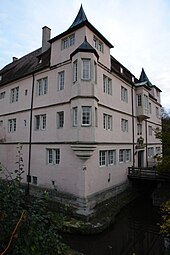Pole rings
|
Pole rings
Ammerbuch municipality
|
|
|---|---|
| Coordinates: 48 ° 32 ′ 0 ″ N , 8 ° 57 ′ 0 ″ E | |
| Height : | 362 m |
| Area : | 4.84 km² |
| Residents : | 1742 (March 1, 2015) |
| Population density : | 360 inhabitants / km² |
| Incorporation : | 1st December 1971 |
| Postal code : | 72119 |
| Area code : | 07073 |
|
Location of Poltringen in Ammerbuch
|
|

Poltringen is a district of Ammerbuch in the Tübingen district , in the middle of Baden-Württemberg . Until 1971 it was an independent municipality.
Historical coat of arms
The coat of arms of Poltringen showed a standing, red-tongued black boar in silver on a green three-mountain and above a five-petalled red rose. The coat of arms was valid until Ammerbuch was founded in 1971.
history
The foundations of Roman manors were found in Poltringen as the oldest traces of settlement. A Roman road, later also called Königsstraße or Ammertalstraße , led from Sumelocenna (today Rottenburg ) via Unterjesingen, Poltringen, Reusten and Altingen to Herrenberg and on to Portus (today Pforzheim ). From 84 to 260 AD, the Ammer valley was ruled by the Romans before they were ousted by the Alemanni , who settled in the 3rd century.
Presumably in the 5th or 6th century the village was formed at its current location. For a long time the village was owned by the Counts of Nagold and later by their successors, the Count Palatine of Tübingen . It was fortified by a castle. In 1293 the Count Palatine sold their property to the Bebenhausen Monastery . In Poltringen an imperial manor was added that was not subordinate to the monastery.
For the first time in 1426 a convent of Franciscan nuns was mentioned in Poltringen, which existed at the "upper church", the parish church of St. Stephen. This burned down in 1647, afterwards the buildings were rebuilt, but were already empty from 1665.
After the dissolution of the Bebenhausen monastery as a result of the Reformation , one third of Poltringen came into the possession of Württemberg and two thirds into the possession of Austria , so that it remained partially Catholic as part of Upper Austria . With the decree of Napoleon Bonaparte of 1806, Poltringen came to Württemberg with the rest of the western Austrian estates. Since 1808 Poltringen has been under the administration of the Herrenberg Office . In the reorganization of 1938 it fell to the Tübingen district .
The formerly independent municipality of Poltringen merged with five other municipalities to form the municipality of Ammerbuch on December 1, 1971 .
politics
Poltringen has a local council with five members (2 - CDU; 2 - BWG; 1 - Greens) and a local councilor .
religion
Historically, Poltringen had a predominantly Catholic population. Even today the majority of the population is still Catholic. There are two Catholic churches in the village, namely the St. Stephen's Church with an onion dome on the outskirts towards Reusten and the St. Klemens Church in the center. The Protestant parish in Poltringen does not have its own church in town and is assigned to the Protestant parish in Pfäffingen .
education
There is a Catholic kindergarten and a primary school in Poltringen.
Attractions
The town on the Ammer has primarily the moated castle to offer, but it is not open to the public. The castle was rebuilt in the Renaissance style in 1613 under the direction of Heinrich Schickhardt . Also worth seeing is the mill right next to it, which today houses a shop and a hall for festive events.
Infrastructure
Poltringen, which is almost exactly halfway (10 km each) between the university town of Tübingen and Herrenberg , has a bus connection to the Pfäffingen stop of the Ammertalbahn , which connects Tübingen with Herrenberg. The federal highway 28 ( Kehl - Ulm ) runs near the place.
freetime and sports
In the local area of Poltringen there is a sports field, a tennis hall with several sand courts, a riding hall, the event hall of the Poltringer Fasnets Club, a hiking hut and an airfield.
The soccer striker Kim Kulig began her soccer career at the age of eight with SV Poltringen, where she played in a boys' team. The U-20 world champion of 2010 plays today for the Bundesliga club 1. FFC Frankfurt and the national team .
Carnival
The Poltringer have the nickname "Bockmoster" because, according to legend, a billy goat jumped into the cider press while pressing apple juice and wanted to eat the apples.
In 1967 Walter Ulrich designed a Swabian-Alemannic Carnival costume called Bockmoster for a white jester , the wooden mask that went with it and the bell crockery. Today there are around 80 active Bockmosters and 35 children who wear the so-called Narrenhäs , the Larva , the Krukke (scaled-down replica of a cider jar) and the Gschell during Carnival time .
Airfield
The Poltringen special landing site with the ICAO code EDSP is located in the Poltringen district . The aviation clubs Ammerbuch, Herrenberg and Unterjesingen are based there. They operate eight powered aircraft and 16 gliders there with several hundred members.
swell
- ^ Federal Statistical Office (ed.): Historical municipality directory for the Federal Republic of Germany. Name, border and key number changes in municipalities, counties and administrative districts from May 27, 1970 to December 31, 1982 . W. Kohlhammer, Stuttgart / Mainz 1983, ISBN 3-17-003263-1 , p. 535 .
- ↑ YouTube video by Wolfgang Wulz: Ortsnecknames
- ↑ Bock Moster , Poltringer carnival Club 1966 e. V.




